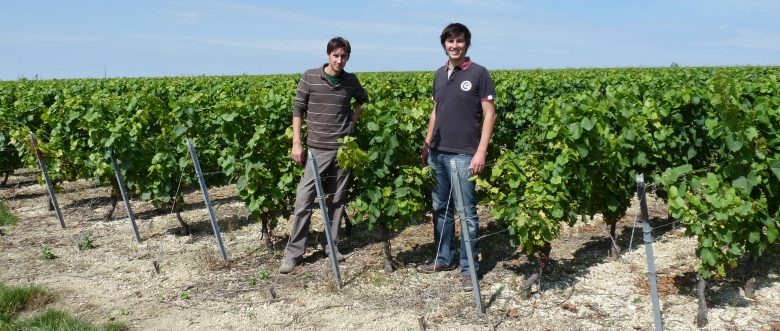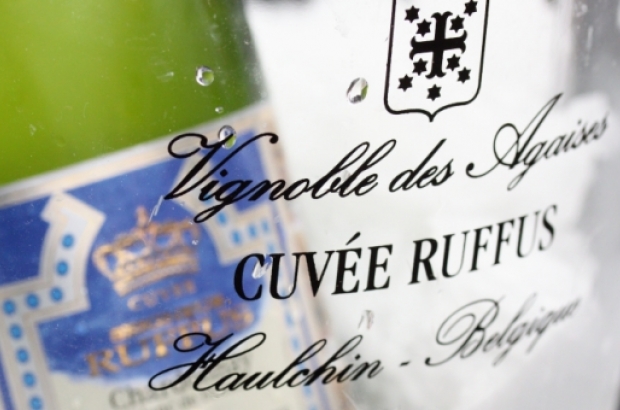- Daily & Weekly newsletters
- Buy & download The Bulletin
- Comment on our articles
Belgian bubbles: Ruffus sparkling wines
The Leroy family are living proof that persistence, passion and exuberance can all successfully be bottled. The largest vineyard in Belgium and the main producer of sparkling wine has been winning awards and selling out since launching 10 years ago.
Fourth-generation Binche wine merchant and enthusiastic oenologist Raymond Leroy first spotted the potential of a strip of chalky land close to the French border almost 30 years ago. Its farming owner was not interested in selling or renting the ground, so Leroy had to be content with planting a couple of vines in his garden. But he never forgot that south-facing sloping terrain close to the village of Estinnes.
Twenty years later, a chance meeting with the farmer’s son led to the founding of Domaine des Agaises and a fruitful collaboration that includes to this day French Champagne-growing friend Thierry Gobillard and two local friends. On the advice of Gobillard, the fledgling growers planted two hectares to test the viability of their product and the site.
That was in 2002, and each year the domain has progressively grown to its present size of 14 hectares and production of 100,000 bottles a year. Visiting the site on a damp summer day, not even the drizzle can detract from what is a glorious bucolic spot. Farm tracks, herds of cows, copses of trees and rows and rows of orderly vines bearing low-lying clusters of grapes stretch along the inclining land.
The combination of the exceptionally chalky soil – a geological extension of the ridge on which France’s Champagne region is founded– plus hillside and southern orientation are the key to the success of the domain, as Leroy’s sons, John and Arnaud, explain: “This is the only chalk area in Belgium and it is necessary, as it drains well.” An enormous hole lies next to the vineyard, an old lime oven that “proves the site had already been exploited for its chalk vein that is an extension of the Champagne growing area.”
John, 27, an agricultural engineer who pursued oenology studies in Montpellier like his father and also worked in a New Zealand vineyard, shows the vine stock that originates from Champagne, planted in the pebbly and mulched soil. Grafted on to these vines are the Ruffus varieties of 80 percent Chardonnay, 10 percent Pinot noir and 10 percent Pinot meunier.
As he describes the intricate and precarious daily process of growing vines, from the precise spacing of the plants to trigger the correct amount of growth, to the battle against bacteria and the dependence on fine dry weather, it is clear this is a labour of love for the whole family. It is also evident that vintners need nerve, confidence and a dash of foolhardiness.
Traditional winemaking
Cultivation is an expensive business. “It costs approximately €25,000 per hectare without the land, so the vineyard represents a massive investment,” explains Arnaud, 30, a former IT consultant who is now responsible for the company’s marketing.
The fine spring weather encouraged growth early in the year and the Leroy family report an excellent harvest despite the cool and wet summer. Some 400 volunteers descended to share in the round-the-clock business of grape-picking, although machinery is increasingly finding its place in the traditional process.

At the domain’s nearby farm base, the infrastructure is impressive, with enormous thermo-regulated tanks and pressers originating from France. The production of sparkling Champenoise-style wine, known as méthode traditionnelle, is another exacting art. After pressing, the clear juice is collected and ferments for two weeks at low temperature in stainless steel tanks. When the wine is bottled, a mixture of sugar and yeast is added to provoke fermentation, which gives the wine its effervescence and fullness of flavour. The bottles then spend one year on slats to repose before being disgorged to remove the yeast deposit.
Ruffus produces dry wines, aiming for a crisp, mineral product, suitable for aperitif or accompanying a light starter, with a final alcohol content of 12.5 percent. “On an aesthetic level, we try to produce constant bubbles from the bottom of the glass to the top,” explains John. “For the taste, we are looking for a good effervescence. It is possible to dose the sugar with part of the previous year’s wine for continuity of flavour, but as we always sell out there are some variations.”
The top of the top
While about 500 litres is exported to neighbouring countries, the majority stays in Belgium, with half sold in the Hainaut province, 20 percent in Brussels, and the rest in other parts of Wallonia. Private buyers and wine merchants reserve almost a year in advance and collect their order during a three-week period in June when the domain also opens its doors to the public. Since its launch, each year’s production has sold out, a success confirmed by the awards and medals earned as well as a loyal clientele that includes many gastronomic restaurants.
As 2009 was a good year for all winemakers, Ruffus decided to produce a vintage wine, a blend of all three wine varieties left to mature for three years with a period in wooden casks. The 3,000 numbered bottles of Franco Dragone Vintage (named after the local Hainaut theatre director who designed the label) will be available in 2012 (costing approximately €38). “We have aimed for something that is really the top of the top,” says Arnaud.
Since 2006 the vineyard has possessed the attribution ‘Cremant de Wallonie’, although it is not included on the label as preference has been given to the promotion of the name Ruffus, or Seigneur Ruffus in tribute to the first Lord of Estinnes. “We thought it worked well in all languages and was memorable. The name Le Domaine des Agaises means ‘white soil’ in local dialect, which is also quite appropriate,” adds Arnaud.
The Ruffus label features the famous Gilles of Binche. The inclusion of this colourful carnival image has particular resonance for the brothers. As proud Gilles, they dress up each year for the world-renowned tradition. An important part of the Gilles ceremony is quaffing champagne and oysters at 6.00 in the morning. Arnaud jokes: “Hopefully one day this will be replaced by Ruffus.”
www.ruffus.be
This article first appeared in WAB magazine
Belgium also produces an exquisite single malt whisky...









